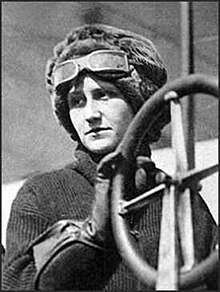Julia Clark
Julia Clark (December 21, 1880 – June 17, 1912) was the third woman to receive a pilot's license from the Aero Club of America, and the first American woman to die while piloting an airplane. She earned her pilot's license on May 19, 1912 and died less than one month later.

.jpg)
Biography
Clark was born in Bangor, Michigan on December 21, 1880. Her family moved to California and subsequently to Denver[1] where she worked as a stenographer.[2] Her interest in flying began when she attended the 1911 Chicago International Aviation Meet. After first overcoming Glenn Curtiss' reluctance to train women pilots, she was enrolled in his flying school in San Diego[3] where, on May 19, 1912, she earned her pilots license (#133) after soloing to 1,000 feet.[2] She then joined the Curtiss-Wright Aviators exhibition team, being billed as "The Daring Bird-Girl"[4] and contracted for several exhibitions in the Midwest. On June 17, 1912, in Springfield, Illinois,[5] she decided to make a test flight around dusk. Visibility was poor and, after striking a tree limb, the plane, a Curtiss pusher, tumbled to the ground, pinning her beneath the wreckage. She died after being rushed by automobile to the hospital, having never regained consciousness. Her body was sent to her home in Denver.[3]
Clark was the first American woman to die in an air accident, preceding Harriet Quimby's death by two weeks.[6] She was also said to be the first licensed woman pilot to die piloting an aircraft. The previous two woman pilots who died, Denise Moore in July 1911 and Suzanne Bernard in March 1912, died prior to earning their licenses. Moore and Bernard were both attending Henri Farman's flying school, in Étampes-sur-Marne, France at the time of their deaths.[7][8]
References
- Lebow, Eileen F. (2002). Before Amelia : women pilots in the early days of aviation (1st ed.). Washington, D.C.: Brassey's, Inc. pp. 249–251. ISBN 9781574884821.
- "Aviatrix Meets Death". Perrysburg Journal. Perrysburg, Ohio. June 21, 1912. p. 2. Retrieved 3 October 2016.
- "Woman Aviator falls to death". El Paso Herald. El Paso, Texas. June 18, 1912. p. 10. Retrieved 3 October 2016.
- "Curtiss Wright Aviators Advertisement". Aerial Age. Aerial Age Publishing Company. 1 (1): 24. June 1912.
- "WOMAN AVIATOR KILLED.; Miss Julia Clark of Chicago Falls at Springfield, Ill". The New York Times. June 18, 1912.
- "Harriet Quimby and Passenger Dashed to Death". The Day Book. Chicago, Illinois. July 2, 1912. p. 12. Retrieved 3 October 2016.
- "Woman Aviator Killed". New York Tribune. New York. July 22, 1911. p. 1.
- "Woman Aviator Killed". New York Tribune. New York. March 11, 1912. p. 1.
External links
- Julia Clark at EarlyAviators.com